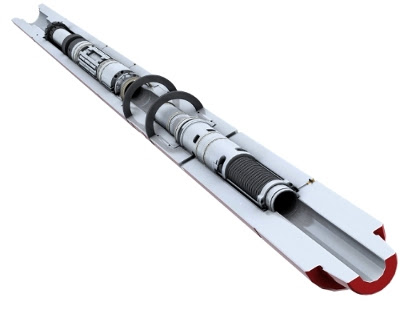Geospatial navigation, analysis service provides real-time 360-degree view
Baker Hughes has released its VisiTrak geospatial navigation and analysis LWD service. This LWD service combines advanced prewell modeling, deep-reading LWD sensors, proprietary visualization software and precise reservoir navigation to improve efficiency in well construction and facilitate optimal well placement for increased hydrocarbon recovery, a product announcement stated. The Visi-Trak LWD service simplifies prewell planning and logistics with interpretation capabilities for complex geological scenarios, facilitating accurate prewell models and well designs without the need to drill costly pilot holes. While drilling, extended-depth LWD readings determine the distance to and angle of adjacent bed boundaries to visualize complex reservoir architecture in real time up to 30 m (100 ft) from the wellbore in every direction. In comparison, conventional LWD tools are typically limited to less than 6 m (20 ft). The combination of early detection and advanced visualization allows operators to precisely and efficiently navigate to and through the reservoir’s most productive zones to improve ultimate recovery. bakerhughes.com

Flying node system advances deepwater OBS
Autonomous Robotics is developing a flying node system that operates as a swarm of AUVs for recording ocean-bottom seismic (OBS) data, the company said in a press release. This technology has the potential to hugely disrupt the offshore seismic market. OBS surveys record very high-quality data especially suitable for field appraisal and development. Unfortunately, the cost of gathering such seismic data at extreme depths in complicated geology remains high. Using the flying node system, the company predicts a tenfold increase in the deployment and recovery rates compared to ROV-deployed nodes, which should help to substantially reduce this cost. The planned system foresees the deployment of 3,500 flying nodes from a vessel, which then descend (fly) to a predetermined position on the seabed. The flying nodes are accurately positioned on the seabed using an ultrashort baseline acoustic navigation system mounted on an unmanned surface vessel, allowing both 3-D (exploration) and 4-D (production/life-of-field) seismic. The nodes will have the ability to remain on the seabed recording data for up to 60 days to cover a wide range of survey requirements. autonomousroboticsltd.com
Inert tracer technology optimizes sand-stimulated completions
CARBO Ceramics Inc. has released CARBONRT ULTRA, a new easily detectable inert tracer technology for sand-stimulated completions in vertical and horizontal wells, a release stated. CARBONRT ULTRA enables the detection and evaluation of near-wellbore proppant location and quantity. This evaluation provides an accurate measurement of perforation cluster efficiency and near-wellbore connectivity to maximize ultimate recovery. Understanding proppant placement also supports the optimization of stage placement and proppant diversion. Information gathered from these diagnostics enables operators to reduce costs and ultimately improve their completions efficiency, the company said. CARBONRT ULTRA proppant technology is detectable with a standard neutron logging tool. The tracer does not dissolve or wash away and is permanently identifiable, providing operators the flexibility to conduct post-fracture logging months or years after fracturing. CARBONRT ULTRA is blended at an engineered ratio with sand prior to or during pumping operations. carboceramics.com
Underwater positioning solution designed for seabed seismic acquisition
Sercel has released GeoTag, the acoustic positioning solution for seabed seismic acquisition. GeoTag can be used to accurately position all types of ocean-bottom cable (OBC), ocean-bottom node and transition zone cable systems for seabed seismic surveys in water depths down to 500 m (1,640 ft), a press release stated. The highly flexible and reliable GeoTag product operates with the smallest acoustic positioning transponder available on the market. The transponders are attached to the seabed seismic equipment and interrogated by a vessel-based transceiver. GeoTag’s design allows rapid maintenance such as battery replacement for improved crew effi ciency. The transponders also can be stored on a reel and deployed mechanically when used with OBC systems for seamless and cost-effective operations. With the addition of GeoTag’s acoustic positioning capability, Sercel now offers a complete acquisition solution for a wide range of seabed seismic surveys. GeoTag is fully scalable for use on small to large seabed crews deploying up to 10,000 acoustic positioning devices. cgg.com

Valve cages help prevent injuries while servicing compressor valves
Zahroof Valves Inc. (ZVI) has released the ZVI Valve Cage-Integral and ZVI Valve Cage-Removable. The lighter ZVI Valve Cage assembly is designed to be safer and easier to install and remove than conventional valve and cage assemblies, especially for larger discharge valves, according to a product announcement. The ZVI valve cages have a better fl ow path for gas, with larger rounded ports that can be directly fastened to the ZVI valve. Made of corrosion-resistant steel similar to the valve body itself, the cage will not corrode under normal conditions and is easily repairable, reducing unnecessary costs, the company said. The ZVI Valve Cage-Integral features a ZVI StraightFlo (SF) Valve with a cage that does not need to be removed from the valve during servicing, installation or removal of the valve from the cylinder. Available for valves of all sizes, the ZVI cage’s height can be easily modifi ed to accommodate spacers or new valves. The ZVI Valve Cage-Removable can be used with a ZVI SF Valve or with conventional valves. In the case of an existing SF Valve, it can be directly fastened to the valve, making installation and removal of the valve safer and easier without the need of special tools. zahroofvalves.com

Slow-release long-lasting inhibitors prevent scale, corrosion
U.S. Water has released its new ScaleGone and ScaleGone CI, a long-lasting slow-release solid scale inhibitor (SI) and combined SI/corrosion inhibitor (CI) for hydraulic fracturing fl uids as well as for use in producing wells, the company said. ScaleGone solid SI particles, which measure the same size as proppant, can be introduced during stimulation treatment, ensuring distribution throughout the well fracture. Safe to use with other stimulation products, ScaleGone slowly releases into produced fl uids. In addition, ScaleGone can be introduced into already producing wells. ScaleGone and ScaleGone CI provide long-lasting scale and corrosion protection, up to several years depending on loading. These products can prevent deposition in the wellbore area and the tubing just as powerfully as they do at the formation face to prevent scale and costly production problems. uswaterservices.com
Circulation sub maximizes efficiency of deepwater operations
Weatherford International Plc has released its JetStream Radio Frequency Identifi cation (RFID) circulation sub, a release stated. Poor wellbore integrity can cause events such as stuck pipe, wellbore collapse, sloughing shales and lost circulation, which are major concerns for drillers in deep water. The JetStream RFID circulation sub enables operators to run a series of tools at different positions along the drillstring and remotely actuate the valves an unlimited number of times in a single trip to achieve higher flow rates and cleaner wellbores. “As operators deal with more complex wellbores, the ability to drop an RFID tag from the surface and circulate it through the sub enables our clients to open and close downhole tools multiple times, which provides superior operational fl exibility and saves days of rig time. In deepwater drilling operations, RFID technology can save the client over $1 million per application by reducing the amount of nonproductive time. This is critical in the current economic environment,” said Neil Gordon, vice president of intervention services and drilling tools at Weatherford. weatherford.com/jetstream

Recommended Reading
E&P Highlights: Jan. 13, 2025
2025-01-13 - Here’s a roundup of the latest E&P headlines, including Chevron starting production from a platform in the Gulf of Mexico and several new products for pipelines.
Production Begins at Shell’s GoM Whale Facility
2025-01-09 - Shell’s Whale floating production facility in the Gulf of Mexico has reached first oil less than eight years after the field’s discovery of 480 MMboe of estimated recoverable resources.
E&P Highlights: March 31, 2025
2025-03-31 - Here’s a roundup of the latest E&P headlines, from a big CNOOC discovery in the South China Sea to Shell’s development offshore Brazil.
E&P Highlights: Jan. 27, 2025
2025-01-27 - Here’s a roundup of the latest E&P headlines including new drilling in the eastern Mediterranean and new contracts in Australia.
Shell Takes FID on Gato do Mato Project Offshore Brazil
2025-03-23 - Shell Plc will be the operator and 50% owner, with Ecopetrol holding 30% interest and TotalEnergies 20%.
Comments
Add new comment
This conversation is moderated according to Hart Energy community rules. Please read the rules before joining the discussion. If you’re experiencing any technical problems, please contact our customer care team.





